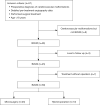One-stop hybrid operation versus microsurgery for treating brain arteriovenous malformation in children-a retrospective case series
- PMID: 39144421
- PMCID: PMC11320018
- DOI: 10.21037/tp-24-68
One-stop hybrid operation versus microsurgery for treating brain arteriovenous malformation in children-a retrospective case series
Abstract
Background: Brain arteriovenous malformation (BAVM) is one of the most common causes of cerebral hemorrhage in children. The effectiveness of one-stop hybrid operation in the treatment of BAVM in adults has been widely confirmed, but there are few study for the case in children. The aim of this study was to retrospectively analyze of the role and significance of one-stop hybrid surgery versus microsurgery in the treatment of BAVM in children.
Methods: A total of 57 children (≤18 years old) with BAVM who were admitted to The 900th Hospital and Fujian Children's Hospital between September 2018 and August 2022 were retrospectively analyzed. According to the inclusion and exclusion criteria, 38 patients were included, and they were divided into a microsurgical group (25 patients) and a hybrid operation group (13 patients) according to the treatment modality. The following clinical characteristics were observed: sex, age, initial symptoms, presence or absence of signs, Glasgow Coma Scale (GCS) score, Hunt-Hess grade, imaging characteristics such as the location of the BAVM, Spetzler-Martin (S-M) grade, presence of intraventricular hemorrhage, treatment and prognostic indicators such as intraoperative blood loss, operation time, imaging cure, postoperative complications, length of hospital stay, and 3- and 6-month modified Rankin score (mRS) after the operation.
Results: The proportions of female patients (P=0.042), patients whose BAVM were located in the supratentorial region (P=0.034) and patients whose S-M grade was above grade III (P=0.003) were greater in the hybrid operation group than those in the microsurgical group. The intraoperative blood loss (P<0.001), operation time (P<0.001) and postoperative hospital stay (P=0.024) of patients in the microsurgical group were greater than those in the hybrid operation group. The presence of signs and the S-M grade may be relevant factors in predicting the surgical approach, and the probability of selecting a hybrid operation for each step of increasing the S-M grade was 3.046 times that of microsurgery.
Conclusions: A one-stop hybrid operation is effective and safe for the treatment of BAVM in children. High S-M grades of BAVM are more suitable for hybrid operation.
Keywords: One-stop hybrid operation; brain arteriovenous malformation (BAVM); case series; children; microsurgery.
2024 Translational Pediatrics. All rights reserved.
Conflict of interest statement
Conflicts of Interest: All authors have completed the ICMJE uniform disclosure form (available at https://tp.amegroups.com/article/view/10.21037/tp-24-68/coif). The authors have no conflicts of interest to declare.
Figures


Similar articles
-
Combined Microsurgery and Endovascular Intervention in One-Stop for Treatment of Cerebral Arteriovenous Malformation: The Efficacy of a Hybrid Operation.Cell Transplant. 2019 Aug;28(8):1018-1024. doi: 10.1177/0963689719845366. Epub 2019 Apr 24. Cell Transplant. 2019. PMID: 31018668 Free PMC article.
-
One-Stage Treatment in a Hybrid Operation Room to Cure Brain Arteriovenous Malformation: A Single-Center Experience.World Neurosurg. 2021 Mar;147:e85-e97. doi: 10.1016/j.wneu.2020.11.123. Epub 2020 Dec 19. World Neurosurg. 2021. PMID: 33348099
-
Treatment of high-grade brain arteriovenous malformations using a hybrid operating room: A prospective single-arm study.Clin Neurol Neurosurg. 2023 Jan;224:107517. doi: 10.1016/j.clineuro.2022.107517. Epub 2022 Nov 12. Clin Neurol Neurosurg. 2023. PMID: 36436434
-
Critical review of brain AVM surgery, surgical results and natural history in 2017.Acta Neurochir (Wien). 2017 Aug;159(8):1457-1478. doi: 10.1007/s00701-017-3217-x. Epub 2017 May 29. Acta Neurochir (Wien). 2017. PMID: 28555270 Review.
-
Microsurgery versus Microsurgery With Preoperative Embolization for Brain Arteriovenous Malformation Treatment: A Systematic Review and Meta-analysis.Neurosurgery. 2023 Jan 1;92(1):27-41. doi: 10.1227/neu.0000000000002171. Epub 2022 Oct 26. Neurosurgery. 2023. PMID: 36519858
References
LinkOut - more resources
Full Text Sources
